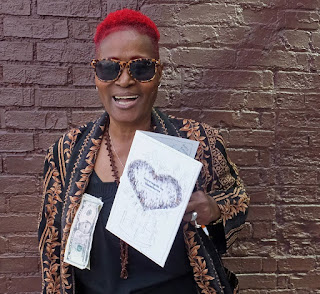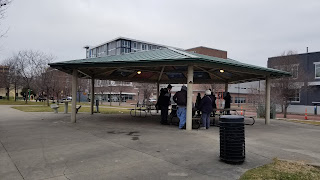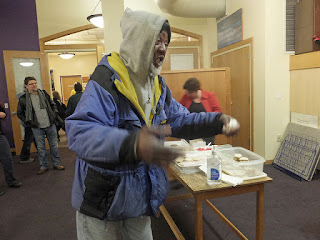 Rev. Andy DeBraber
Rev. Andy DeBraber
CEO, Heartside Ministry
December 19, 2015
Preached at Worship Focused on Justice
at LifeQuest
The Social Justice (of) Movement
Acts
2:44-47a
All who believed were
together and held all things in common; they would sell their possessions and
goods and distribute the proceeds to all, as any had need. Day by day, as they
spent much time together in the temple, they broke bread at home and ate their
food with glad and generous hearts, praising God and having the goodwill of all
the people.
The believers in Acts held all
things in common. So do we, in our better moments, for "The earth is the
Lord's and all that is in it and all the people therein" (Psalm 24:1).
But sometimes we forget.
Like in 1888, when a streetcar riot
took place in Grand Rapids. It's probably not what you think. Let me back up a
moment. At the time, Grand Rapids was a leader in public transportation, with
street cars running from downtown to popular destinations at John Ball Park,
North Park, and Ramona Park. As Toni Bal writes in review of historian Carl
Bajema's work:
The first streetcar
from downtown to Ramona Park at Reed’s Lake [ran] in July of 1875. A huge
social innovation for the time, only the wealthier families could afford the
time consuming and costly transportation through dense forest and undeveloped
land on the outskirts of the city to the resorts. With a five-cent fare on the
streetcar line, however, the working class could now join the wealthy class for
an afternoon at the lake or hillside park or river. Each of the resorts offered
free as well as paid entertainment in order to include anyone attending. Grand
Rapids Railway Company actually subsidized bands to provide free music at John
Ball Park in order to keep people paying the five-cent fare back and forth (The Rapidian, May 6,
2015).
The route to Ramona Park was so
popular that another route there was being laid in 1888. And it went right
alongside Eastern Avenue Christian Reformed Church. "What they considered
a symbol of encroaching secularism would endanger their children, rattle their
windows, and disrupt their Sunday services. Worse, it would transport sinners
to Ramona Park, [the devil's playground,] for revelry, dancing, and gambling,
all verboten" (Local Legends of Grand Rapids, Norma Lewis & Jay de
Vries).
After legal attempts failed to stop
the new route, 20 church members took to the street to pull up the rails as
they were being laid. Police dispersed the crowd and workers labored through
the night to finish that section of the track. The next day, however, the
church bells called the faithful back, this time 1,000 strong, tearing up the
rails again and throwing them into the nearby Frog Pond. As quickly as police
could pile people in the paddy wagons, their friends pulled them out.
I tell you this because it's a fun
story.
I tell you this because it happened
just down the street here.
I tell you this because it is
symbolic of how public transportation can divide us.
And I tell you this because it is a
cautionary tale of how we continue to use public transportation to divide us
day after day in much more subtle ways.
We forget that we hold all things in
common, that breaking bread together is at the core of living fully human lives
in community, that the earth is the Lord's and all the people therein.
Do you know how many places in
greater Grand Rapids the bus does not go? We don't need to rip up streetcar
lines anymore, we just don't allow bus service there - where doctors and
lawyers and government offices and public parks remain free from "those
people." This is publicly funded segregation, or as Congressman John Lewis
puts it, "Our struggle is not over. The physical signs are gone, but the
legacy of 'Jim Crow' transportation is still with us" (Highway Robbery:
Transportation Racism and New Routes to Equity, ed. Robert Bullard, Glenn Johnson, Angel
Torres).
Do you know how much it costs to own
and maintain a car? On average, nearly $8,000 per year, second only to housing
in most household budgets - more than on food or education or health care.
Do you know how many households have
no car? Eight percent of all American homes, but 22 percent of African American
homes and 16 percent of Latino homes. American transportation policies
disenfranchise the poor with strong racial overtones.
As Gerard Wellman states in his
article “The Social Justice (of) Movement,” from which the name of this talk is
taken:
By denying subgroups of
American population the right to use public buses, obtain drivers' licenses, or
even through a “roads-only” transportation system which necessitates the
expensive purchase of a private automobile, dominant segments of society can
restrict undesired groups' social mobility."
Throughout the United
States' troubled history of race and gender relations, the simple ability to
travel from one location to another has been a crucial element of social
justice. Keeping African-Americans, women, and other minority groups "in
their place" frequently became a preoccupation of dominant groups to limit
other groups' physical and social mobility.
We forget that we hold all things in
common, that breaking bread together is at the core of living fully human lives
in community, that the earth is the Lord's and all the people therein.
Two examples of how this
forgetfulness plays out practically here in Grand Rapids today:
·
Rapid
bus fares recently rose from $3 to $3.50 for a one-way trip, a 16.7% increase,
while monthly passes went from $41 to $47, a 14.6% increase. So the larger
increase went to those least able to pay, a regressive fee increase
disproportionately affecting the poor.
·
While
at the same time, we continue to pour resources into both the Silver Line and
now the Laker Line. One can reasonably argue that these lines most serve the
wealthy in Grand Rapids (real estate developers and college students) while not
improving service to the poorest in the city who use the bus the most, and not
more fully developing the routes that head to the major job centers on the
outskirts of the city.
We forget that we hold all things in
common, that breaking bread together is at the core of living fully human lives
in community, and that the earth is the Lord's and all the people therein.
As much as any issue discussed in
this forum, public transportation or the lack thereof fits most concretely the
working definition of social justice: organizing structures so that everyone
can reach their potential. We can reach our potential when we can get to
doctors and parks and jobs and pharmacies and friends and grocery stories and
families and concerts and church.
Whether we don't drive due to
disability or limited finances, potential is out of reach without public
transit. And better yet, may it be that more and more of us are taking the bus
not out of necessity, but by choice. It's safer, it's better for the
environment, and it builds community in ways that driving a car can never do.
As my good friend and mentor Dave
Bulkowski says, "While public transportation is nobody's number one issue,
it's everybody's number two." Just ask Homer Plessy or Rosa Parks or the
Freedom Riders. Social justice in the United States has a long history of being
intertwined with public transit. I would also commend anyone working on any
social issue to study the long-term impact of Dave's work on public
transportation over the last 20 years. While we may not be where we want to be,
the steady drumbeat of justice has us a whole lot better off than we were two decades
ago. Next on the horizon is a county-wide transit system that works for all of
us.
Then may we be known as the people
of faith who laid down the new tracks that connected us all rather than tearing
them up. Then we will have finally started remembering that we hold all things
in common, that breaking bread together is at the core of living fully human
lives in community, and that the earth is the Lord's and all the people
therein.






















































